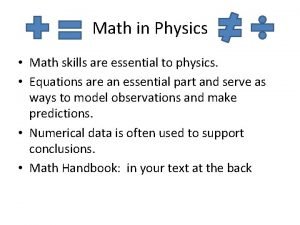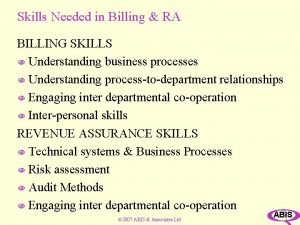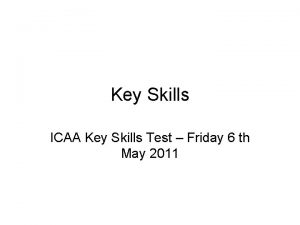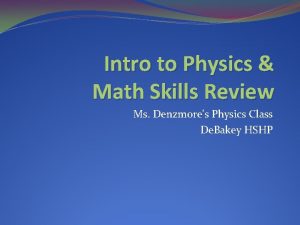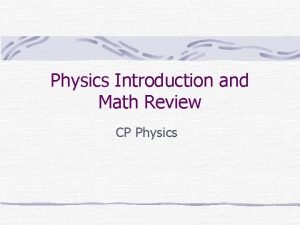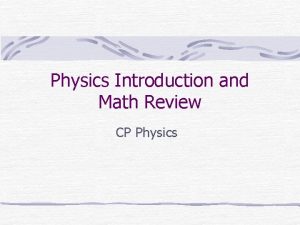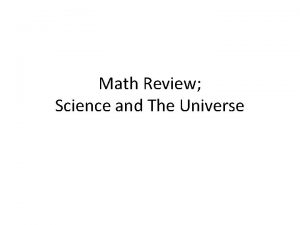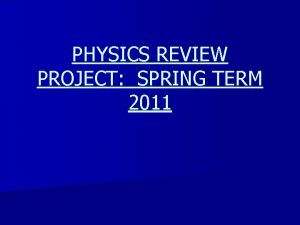Physics Math Review Key Math Skills Needed for



























- Slides: 27

Physics Math Review

Key Math Skills Needed for Success! • Conversions – Know metric conversion factors – Know how to properly convert from one unit to another • Scientific Notation – How to convert between scientific notation and standard notation • Algebra – Solve for x • Geometry/Trig – SOHCAHTOA

Conversions • Metric Base units (100) – Definition: Fundamental unit – Mass: gram (g) – Length: meter (m) – Time: seconds (s) – Temperature: kelvin (K) – Amount of substance: mole (mol) – Volume: Liter (L)

Conversions • Prefixes – Greater than base unit • • Deca- (101), Hecto- (102), Kilo- (103) Deca- = ten, Hecto- = hundred, Kilo- = thousand Abbreviations: Deca da, Hecto h, Kilo k Example: 1 hectometer is the same as saying 100 meters or 102 meters – Less than base unit • • Deci- (10 -1), Centi- (10 -2), Milli- (10 -3) Deci- = 1/10, Centi- = 1/100, Milli- = 1/1000 Abbreviations: Deci d, Centi c, Milli m Example: 1 centimeter is the same as saying onehundreth of a meter or 10 -2 meters

Conversions • Conversion factors – All conversion factors must equal 1 – Conversion factors take the form of a fraction – Just as 5/5, 28/28, and 142/142 all equal 1, there are multiple ways of writing conversion factors that equal 1. – Example: __100 cm__, __1 km__, __1000 m__ 1 m 1000 m 1 km

Conversions • Conversion Factors – How to read them • Example: __1000 mm__, there are 1000 1 m millimeters in 1 meter. • Ask yourself, “Does this make sense? ” – How to properly write them • The smaller unit always gets the number greater than 1

Practice • Write the 2 possible conversion factors you would use to convert from… – cm to m – m to cm – kg to g – g to kg – ms to s – s to ms

Conversions • How do I know which unit goes in the numerator and which unit goes in the denominator when making my conversion factor? – The unit that you are converting FROM always goes in the denominator – The unit you are converting TO always goes in the numerator

Practice • Convert the following (make sure to properly write your conversion factor): – 42 cg = ? g – 6 m = ? km – 132 ms = ? s – 86 kg = ? g

Conversions • What if I am not converting to my base unit? For example, 58 cm = ? km – First convert your know quantity to your base unit • 58 centimeters equals how many meters • 58 cm =. 58 m – Second convert your base unit to your desired unit • . 58 meters equals how many kilometers • . 58 m =. 00058 km

Practice • • • 9 mm = ? cm 18 kg = ? dag 95 mg = ? kg 63 cg = ? hg 1, 468 dm = ? km

Scientific Notation • Scientific notation makes the expression of very large or very small numbers simpler. • Makes it easier to keep track of significant figures. • In Physics, you will deal with very large numbers such as the distance from the sun to the Earth which is 149, 600, 000 meters.

Scientific Notation • General form: a x 10 n – a must be a number between 1 and 10 – n must be an integer – Example: These are NOT in scientific notation • 34 x 105… Why? • 4. 8 x 100. 5… Why?

Scientific Notation • What’s the difference between a positive exponent and a negative exponent? – Positive exponents tell you how many times to multiply by 10 – Negative exponents tell you how many times to divide by 10

Scientific Notation • Converting from standard form to scientific notation – Remember… a x 10 n – Move the decimal point left or right until you wind up with a number between 1 and 10 • The number you are left with is “a” – The number of spaces the decimal point is moved is the exponent “n”

Scientific Notation • Converting from standard notation to scientific notation…how do I know if my exponent is positive or negative? – If the decimal is moved to the left, you will have a positive exponent • In other words, “a” is less than the number you started with – If the decimal is moved to the right, you will have a negative exponent • In other words, “a” is greater than what you started with

Practice • Write 3, 040 in scientific notation • Write 0. 00012 in scientific notation • Write 149, 600, 000 in scientific notation – The distance from Earth to the sun • How many kilometers are in 1 meter? (write the answer in scientific notation) • How many milligrams are in 1 kilogram? (write the answer in scientific notation)

Scientific Notation • Converting from scientific notation to standard form – Remember… a x 10 n – If “n” is positive, move the decimal point in “a” to the right • In other words, if “n” is positive your answer will be greater than your original “a” – If “n” is negative, move the decimal point in “a” to the left • In other words, if “n” is negative your answer will be less than your original “a”

Scientific Notation • How to enter a number in scientific notation into your calculator. – Remember… a x 10 n – Enter “a” – Press the “EE” button – Enter “n” – Do NOT press the multiplication button or enter the number 10 • “EE” takes the place of this step

Practice • Write the following in standard form – 4. 01 x 102 – 5. 7 x 10 -3 – 8. 9 x 105 – 6 x 10 -1

Algebra • Solving for “x” • Key things to remember – What you do to the left side of the equation you MUST do to the right side of the equation. – What you do to one term you must do to ALL terms on both sides of the equation • Think back to… order of operations – Please excuse my dear aunt sally – Parentheses exponents multiply divide add subtract – Left to right

Algebra • Solving for “x” • First combine all like terms abiding by order of operations – Remember… • variables do NOT mix with non-variables • 1 x + 1 x = 2 x, 3 x + 4 x = 7 x • x(x) = x², 2 x(6 x) = 12 x², 2 x(3 x²) = 6 x³ – Example: 3 x + 14 – 5 x + x = 2 + 1 + 3(5) – 6 x 14 – x = 18 – 6 x

Algebra • Solving for “x” • Second, move all terms containing a variable to one side of the equation and all other terms to the other side. • Remember… – Opposite of addition is subtraction and vice versa – Opposite of multiplication is division and vice versa • Example: 14 – x = 18 – 6 x 5 x = 4

Algebra • Solving for “x” • Finally, make it so that the coefficient of “x” is 1 – This means divide both sides by the coefficient of “x” – If there are multiple terms on the opposite side, make sure to divide each term by the coefficient – Example: 5 x = 4/5

Algebra • If the variable is in the denominator use cross multiplication • For example… 1. 2.

Algebra • Solving for “x” – If your “x” term is squared then make your last step to take the square root of both sides of the equation – Remember… • you can plug your answer back into the equation – If the left side of the equation equals the right side then you solved for “x” correctly!

Practice 1) 2) 3) 4) 5) 6) 8) x + 10 = 7 6 x + 8 = -28 -6 + 7 x +3 x = -116 6(3 -x) = 48 – 3 x 2 x² = 50 9) 10) 7)
 Convert 5021 cm to kilometers
Convert 5021 cm to kilometers Physics math review
Physics math review Chapter review motion part a vocabulary review answer key
Chapter review motion part a vocabulary review answer key Key partners business model canvas
Key partners business model canvas Business model canvas tripadvisor
Business model canvas tripadvisor Why does it happen
Why does it happen University physics with modern physics fifteenth edition
University physics with modern physics fifteenth edition Physics ia ideas sports
Physics ia ideas sports Kontinuitetshantering
Kontinuitetshantering Typiska drag för en novell
Typiska drag för en novell Tack för att ni lyssnade bild
Tack för att ni lyssnade bild Vad står k.r.å.k.a.n för
Vad står k.r.å.k.a.n för Varför kallas perioden 1918-1939 för mellankrigstiden
Varför kallas perioden 1918-1939 för mellankrigstiden En lathund för arbete med kontinuitetshantering
En lathund för arbete med kontinuitetshantering Särskild löneskatt för pensionskostnader
Särskild löneskatt för pensionskostnader Tidbok yrkesförare
Tidbok yrkesförare A gastrica
A gastrica Vad är densitet
Vad är densitet Datorkunskap för nybörjare
Datorkunskap för nybörjare Tack för att ni lyssnade bild
Tack för att ni lyssnade bild Mall för debattartikel
Mall för debattartikel För och nackdelar med firo
För och nackdelar med firo Nyckelkompetenser för livslångt lärande
Nyckelkompetenser för livslångt lärande Påbyggnader för flakfordon
Påbyggnader för flakfordon Tryck formel
Tryck formel Svenskt ramverk för digital samverkan
Svenskt ramverk för digital samverkan Jag har nigit för nymånens skära
Jag har nigit för nymånens skära Presentera för publik crossboss
Presentera för publik crossboss
